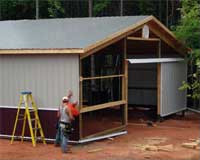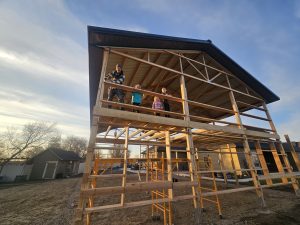More and more consumers are seeing the practicality, unique architectural and energy savings advantages as well as cost savings from a post frame home. This includes loyal reader Brian who writes:
 Hello, my wife and I are considering building a post frame home. We contacted a designer who actually had plans for a home that is close to what we were wanting. He suggested it may be difficult to find a builder that would be comfortable building a pole barn home – so that is why I am contacting several builders to develop a list that could be considered in the future if we move in this direction.
Hello, my wife and I are considering building a post frame home. We contacted a designer who actually had plans for a home that is close to what we were wanting. He suggested it may be difficult to find a builder that would be comfortable building a pole barn home – so that is why I am contacting several builders to develop a list that could be considered in the future if we move in this direction.
Please find the attached plans he provided as a reference and let me know if this is a project you would be willing to tackle. Although we have not bought land we are currently looking in Warren and Clinton counties in Ohio.
Dear Brian: Thank you very much for your interest in a new Hansen Pole Building. We design and provide building plans, installation instructions and materials for totally custom post frame buildings. Your proposed plan (as would be any other plan) is totally doable as a post frame (pole barn) home.
What we do not do is build. Our buildings are designed for the average do-it-yourselfer to successfully construct their own beautiful building, which is why the majority of our clients do their own work. Those who construct themselves, end up with a far better finished result than what you would get from any builder.
In the event you do hire a builder (technically an erector), any builder who can and will read and follow the plans and instructions should prove capable of doing a satisfactory job. Given your geographic location, just a caution based upon experience – there are members of a well know religious group which construct many post frame buildings in your area of the country. While their prices sound too good to be true, it is our experience they do not always build to the provided plans or follow instructions. Again, just a caution. Otherwise a capable erector should be able to construct the building shell for about 50% of what your investment in the materials is.
 I am not normally a fan of “canned” plans for any type of construction, as they are rarely going to meet with the true needs of the client. My best advice is always going to be to determine the spaces needed, determine how large each of those spaces need to be. A good way to find the right size of rooms is to take a note pad, writing tool, and a tape measure and start visiting open houses and home tours.
I am not normally a fan of “canned” plans for any type of construction, as they are rarely going to meet with the true needs of the client. My best advice is always going to be to determine the spaces needed, determine how large each of those spaces need to be. A good way to find the right size of rooms is to take a note pad, writing tool, and a tape measure and start visiting open houses and home tours.
Once room needs and sizes have been determined, starting putting the pieces of the jigsaw puzzle together – place rooms where they are most efficiently grouped for ease of access and use. This may take some adjustments of individual room dimensions, however the resultant will be the most effective. Now, and only now, should you put the “box” around the contents!
 The name for this psychological phenomenon derives from the love millions of Americans display toward their self-assembled furniture (or, dare we say it, their badly self-assembled furniture) from the do-it-yourself store with the Scandinavian name.
The name for this psychological phenomenon derives from the love millions of Americans display toward their self-assembled furniture (or, dare we say it, their badly self-assembled furniture) from the do-it-yourself store with the Scandinavian name.





